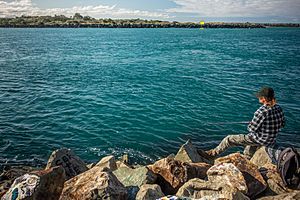Parore facts for kids
Quick facts for kids Parore |
|
|---|---|
 |
|
| Scientific classification | |
| Synonyms | |
|
The parore (Girella tricuspidata) is a type of fish found in the ocean. It's also known as luderick, black bream, or blackfish. This fish belongs to a group called sea chubs. You can find parore in the southwestern Pacific Ocean, near Australia and New Zealand. In New Zealand, people usually call it parore, while in Australia, luderick is the more common name.
Contents
What the Parore Looks Like
The parore has a body that's a bit flat and shaped like an oval. It has a small head with tiny eyes and a small mouth that doesn't reach past its eye. Its jaws have a special outer row of flat, overlapping teeth with three points. Behind these, there's a wide band of tiny teeth that are similar in shape.
Most of the parore's body is covered in small, rough scales. It has a curved lateral line (a special line of scales that helps fish sense vibrations) with 48 to 51 scales that have pores. This line runs along its back.
The parore has one long fin on its back called the dorsal fin. It has 14 to 16 stiff spines and 11 to 12 soft rays. The spines in the middle of the are the longest. The fin on its belly, called the anal fin, is similar to the soft part of the dorsal fin. It has 3 spines and 11 to 12 soft rays.
The tail fin, or caudal fin, is very large and deeply forked, meaning it splits into two points. It has 17 rays. The pectoral fins (on its sides) are small with 16 rays, and the pelvic fins (on its underside) are also small, with one spine and 5 rays.
The biggest parore ever recorded was about 71 centimeters (28 inches) long. However, most parore are around 35 centimeters (14 inches) long. The heaviest one found weighed about 4 kilograms (9 pounds).
Parore are usually dark greenish-grey on their backs. Their sides and bellies are silvery-grey. They often have about 11 thin, dark stripes that go down from their dorsal fin, fading towards their belly. Sometimes, their head and pectoral fins can look yellowish, but usually, their fins are the same color as the part of the body they are closest to.
Where Parore Live
Parore live off the eastern coast of Australia and around New Zealand. In Australia, you can find them from Mackay in Queensland, down to east of Adelaide in South Australia, and around most of Tasmania. In New Zealand, they live on both the east and west coasts of the North Island, from North Cape down to the Cook Strait.
Parore's Home and Habits
Parore like to live in shallow coastal waters and estuaries (where rivers meet the sea). They often gather in large groups near rocky areas and jetties (piers). Young parore, called juveniles, use seagrass beds to hide from animals that might try to eat them.
This fish is an omnivore, which means it eats both plants and animals. Parore use their small, sharp, front teeth to graze on seaweed, especially green algae like Enteromorpha intestinalis and sea cabbage. They also have crushing teeth to grind up algae. Scientists have looked at what's inside their stomachs and found that parore also eat small crustaceans (like crabs or shrimp), pipi, mussels (shellfish), and worms when they get the chance.
Reproduction and Life Cycle
As parore grow up, they gather in big groups. Adult fish move from rivers and coastal lakes out to the sea. They lay their eggs (this is called spawning) in the ocean's surf zone or near the mouths of estuaries, usually in the winter.
Fishing for Parore
People fish for parore for business in New South Wales, Australia. In New Zealand, they are sometimes caught by accident when fishermen are trying to catch other fish, like grey mullet. The fish are usually sold fresh to eat.
Parore are a popular fish for people who fish for fun in Australia. They can be caught using seaweed as bait under a float, or with a special artificial fly that looks like seaweed. In New Zealand, parore are not as popular for recreational fishing. They are mostly caught by people who are trying to catch other types of fish.
Scientific Discovery
The parore was first officially described by scientists Jean René Constant Quoy and Joseph Paul Gaimard in 1824. They named it Boops tricuspidatus. The first place it was found and described was in Shark Bay, Western Australia.
- Tony Ayling & Geoffrey Cox, Collins Guide to the Sea Fishes of New Zealand, (William Collins Publishers Ltd, Auckland, New Zealand 1982) ISBN: 0-00-216987-8



